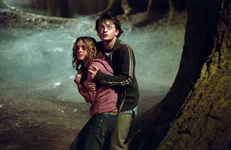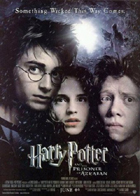Harry Potter and the Prisoner of Azkaban
|  Harry Potter and the Prisoner of Azkaban is the best so far of the film series based on J.K. Rowling’s books about a burgeoning boy wizard. While the first two films were competently directed by Chris Columbus, they relied far too much on the source novels and were almost completely devoid of their own magic. Columbus, hardly Hollywood’s most inventive or visual director, made good adaptations that never really soared. Prisoner of Azkaban, on the other hand, comes very close to soaring. Harry Potter and the Prisoner of Azkaban is the best so far of the film series based on J.K. Rowling’s books about a burgeoning boy wizard. While the first two films were competently directed by Chris Columbus, they relied far too much on the source novels and were almost completely devoid of their own magic. Columbus, hardly Hollywood’s most inventive or visual director, made good adaptations that never really soared. Prisoner of Azkaban, on the other hand, comes very close to soaring.The big change has been replacing Columbus, who bowed out after all the stress of shooting the first two films back to back, with Mexican director Alfonso Cuarón, best known for the indie art-house hit Y tu mamá también() (2001), a highly sexualized coming-of-age story. He also directed 1995’s A Little Princess, a beautiful children’s film that Rowling counts among her favorites. Thus, while Cuarón would seem to be an odd pick to helm the third entry in a big-budget mainstream movie franchise, he turns out to be the perfect choice because he brings a much-needed sense of daring and artistry. He challenges the material by focusing in on one central theme—that of the difficulties of maturation between childhood and adolescence—rather than trying to throw everything on screen that he can as Columbus did. Potter purists will probably be disappointed at the number of subplots that get cut (Prisoner of Azkaban the book is longer than the first two, while the film is actually shorter), but it makes for a better film. Screenwriter Steven Kloves, who also adapted the first two, has written a much leaner script that allows Cuarón to work his own magic. Of course, much is still the same, but with a few slight twists. The familiar Hogwarts School of Witchcraft and Wizardry hasn’t changed, with its cavernous halls, moving staircases, and giant dining hall lit with floating candles. However, Cuarón imbues it with some new, sometimes wickedly funny touches, such as using long shots of the Whumping Willow briskly taking out a bird in a puff of feathers as a transition between scenes. The game of Quidditch, a sort of wizard version of rugby, makes a brief appearance, but Cuarón makes it down and dirty by staging it in a torrential downpour. There are several new fantastic creatures, including a hippograff named Buckbeak, which is a combination of an eagle and a horse, a werewolf, and a transforming rat. The biggest revelation in Harry Potter and the Prisoner of Azkaban, though, is the emotional resonance of the film’s central trio—Harry (Daniel Radcliffe) and his two best friends, Hermione Granger (Emma Watson) and Ron Weasley (Rupert Grint). They have truly grown into their parts over the course of three years, and it’s impossible to imagine any other actors playing them. The emotions in this film are darker, bringing it an edge that the previous films lacked. Simply put, by this time, Harry has been through too much, and his innocence has been lost. Thus, Harry, in particular, has matured since the last outing, and Cuarón highlights Harry’s adolescent angst in a way we haven’t seen before. In the first two films, Harry was often passive until push really came to shove, at which time he became a reluctant hero. Here, he has the built-up anger that every pushed-around 13-year-old feels, and it often erupts in unexpected moments, such as in the opening scene when he “blows up” his nasty aunt. That same angst also feeds Hermione, who is the most proactive of the three, but must cope with being a lone girl in a largely male world. The gender tension is palpable, but just below the surface, and it will be interesting to see if it develops further in the next film (which is slated to be directed by Mike Newell). The story this time around focuses on the escape of a renegade wizard named Sirius Black (Gary Oldman), who has been imprisoned in Azkaban for his role in the deaths of Harry’s parents. Sirius is believed to be in league with Lord Voldemort, the evil and powerful wizard who killed Harry’s parents and has tried to kill Harry several times before. Thus, everyone at Hogwarts is nervous that Sirius will try to sneak in and snatch Harry, thus Azkaban sends out their guards to protect the school. Unfortunately, their guards are hideous, floating entities called Dementors, which look like hooded grim reapers and have the power to suck your soul right out of you. As before, Prisoner of Azkaban continues the tradition of keeping well-known British character actors employed by introducing several new Hogwarts professors, including the new Defense Against the Dark Arts teacher, Professor Lupin (David Thewlis), and Sybil Trelawney (Emma Thompson), the heavily bespectacled and slightly nutty professor of divination. And, after the recent death of Richard Harris, the school’s headmaster Albus Dumbledore is now played by Michael Gambon, who reinterprets Dumbledore as an aged hippie. Because so many of the subplots have been cut, Prisoner of Azkaban has a better flow than the previous two films, which often felt clunky and episodic, though never boring. This is crucial because the final quarter of the film involves a time-traveling gambit in which events are shown twice from different points of view. If it had been further clouded with subplots, this twisty last act might have been too much, turning the film into an overburdened mess. However, Cuarón manages to make it work while also using it to give the otherwise dark film a ray of light at the end. For all its focus on anger, angst, and the pains of growing up, Harry Potter and the Prisoner of Azkaban ends on a deliriously upbeat note, suggesting that Harry recognizes in himself the avenue out of his angst into further maturity. The film’s ending on a freeze-frame suggests a nod to Francois Truffaut’s masterpiece of adolescent angst The 400 Blows (1959), but rather than capturing a moment of complete uncertainty, it captures that ebullient transition into Harry’s new and more confident self. Copyright ©2004 James Kendrick All images copyright ©2004 Warner Bros. |
Overall Rating: 


 (3.5)
(3.5)


